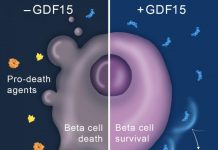A newly discovered gene plays a dramatic role in diabetes among rats, and is also present in nearly identical form in humans, according to researchers at the University of Washington and their colleagues. Further study of the gene may shed light on little-understood processes of the thymus, a vital part of the body's immune system, which sometimes attacks insulin-producing cells in the pancreas leading to type 1 diabetes.
"This gene appears to be absolutely necessary for the development of diabetes in the BB rat, the best model for human type 1 diabetes," says Dr. �ke Lernmark, R. H. Williams Professor of Medicine and adjunct professor of immunology at the University of Washington in Seattle. "The identification of this gene will help us figure out how a gene can fully control if the rat will get diabetes or not. We think this gene may also contribute to human type 1 diabetes."
Lernmark is senior author of a paper describing the findings, published in the July issue of Genome Research. The research was supported by the National Institute of Allergy and Infectious Disease, one of the National Institutes of Health. The work is a collaboration in rat genomics with, among others, Drs. Howard Jacob and Anne Kwitek at the Medical College of Wisconsin in Milwaukee and Dr. Eric Lander at the Whitehead Institute in Cambridge, Mass. Jacob is the Warren P. Knowles Professor of Human and Molecular Genetics and Physiology and director of the genetics center. Kwitek is assistant professor of physiology. Lander is director of the Whitehead's Center for Genome Research.
Type 1 diabetes affects between 0.3 and 1 percent of humans, depending on what population is being surveyed. For more than 20 years, researchers have been studying a particular breed of rat, known as the BB rat, which naturally develops type 1 diabetes and dies unless given insulin. In the current work, the researchers have succeeded in using positional cloning to identify a novel gene, dubbed Ian5 (pronounced 'I A N 5"), with a mutation that results in the deletion of a protein that is found in, among other places, the thymus.
To understand why that's important, it's important to understand the type 1 disease process. Inside the bodies of both humans and rats, bone marrow produces white blood cells, such as T cells, that leave the marrow and travel to the thymus for filtering and processing. The thymus filters and rejects T cells that would harm the body. In a process that is less understood, a healthy thymus then incubates T cells that will be released into the body to fight infections.
Continue Reading Below ↓↓↓
In type 1 diabetes, something goes wrong. T cells are released from the thymus 'thinking' that insulin-producing cells in the pancreas represent an infection that needs to be destroyed. In fact, the insulin-producing cells in the pancreas are necessary to life. When the T cells attack and destroy those insulin-producing cells in the pancreas, the body has to get insulin from another source. This condition is type 1 diabetes, and human patients as well as BB rats will have to take daily shots of insulin to survive.
"Something in the immune system is going wrong. No one is sure exactly what. Now that we have identified the specific gene that is causing an immune system defect, we can try to understand how that gene is acting in its particular context in the immune system normally," said Dr. Armand J. MacMurray, first author of the paper and a senior fellow in the University of Washington's Division of Metabolism, Endocrinology and Nutrition. "That will help us understand what is happening abnormally that is predisposing the rats to the disease, and then see what we can learn about any similar process within humans."
Besides studying the exact function of the Ian5 gene and its protein, researchers will survey if there are any people with type 1 diabetes who may have variants of the Ian5 gene. They have determined that people have an Ian5 gene in the location on chromosome 7 that corresponds to the rat gene's position on its chromosome 4.
This is not the only animal model for diabetes. Other researchers have been scrutinizing the NOD mouse, which also tends to develop type 1 diabetes, but most of its genetic markers don't appear to be as easily isolated. Several authors of the current paper identified in 1992 that there must be a gene on rat chromosome 4 that causes diabetes; they identified the particular gene, Ian5, on the chromosome in January.
Researchers hope that a better understanding of the gene and the function of the thymus could help find answers for diabetes. "One hypothesis is that Ian5, in its regular form, allows T cells to mature properly in the thymus. But perhaps because of this gross defect in the gene, the thymus allows the creation of the defective T cells that are at the root of diabetes," MacMurray says.
Lernmark and colleagues identified a genotype, HLA DQ2/8, which may be responsible for 60 percent of the genetic contribution to type 1 diabetes. Researchers know that it's only responsible for some type 1 diabetes. For example, about 3 percent of children in the state of Washington have the genotype HLA DQ2/8. But of them, only one in 30 of them will develop type 1 diabetes before age 15. So something else besides HLA DQ2/8 must be influencing the outcome. Lernmark speculates that the newly sequenced Ian5 may be a contributing factor to the other 40 percent of genetic contributions.
"Now that Ian5 has been identified also in humans, the team is optimistic that it should not take another 10 years to find out if Ian5 contributes to human type 1 diabetes," Lernmark says.
Source: University of Washington










